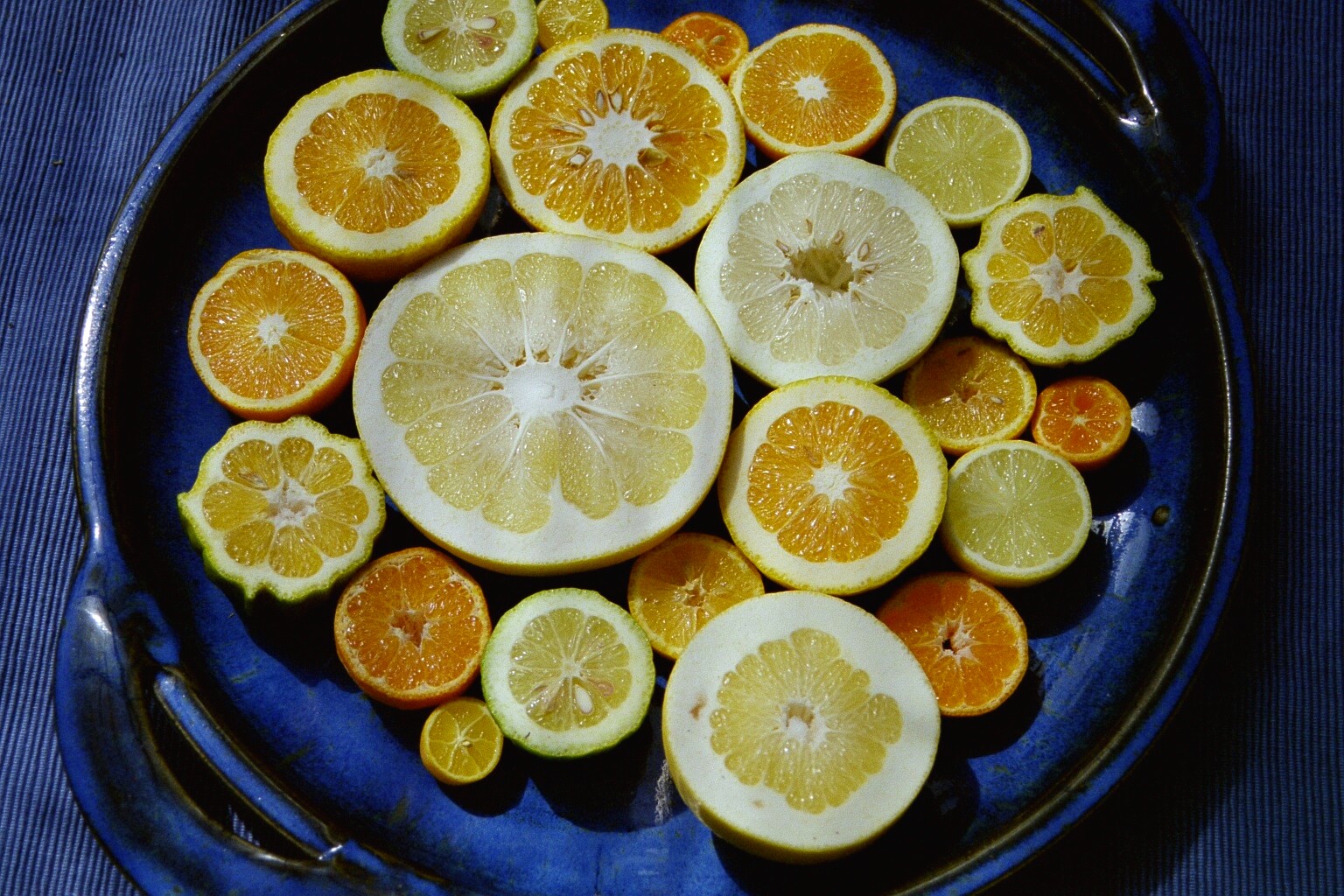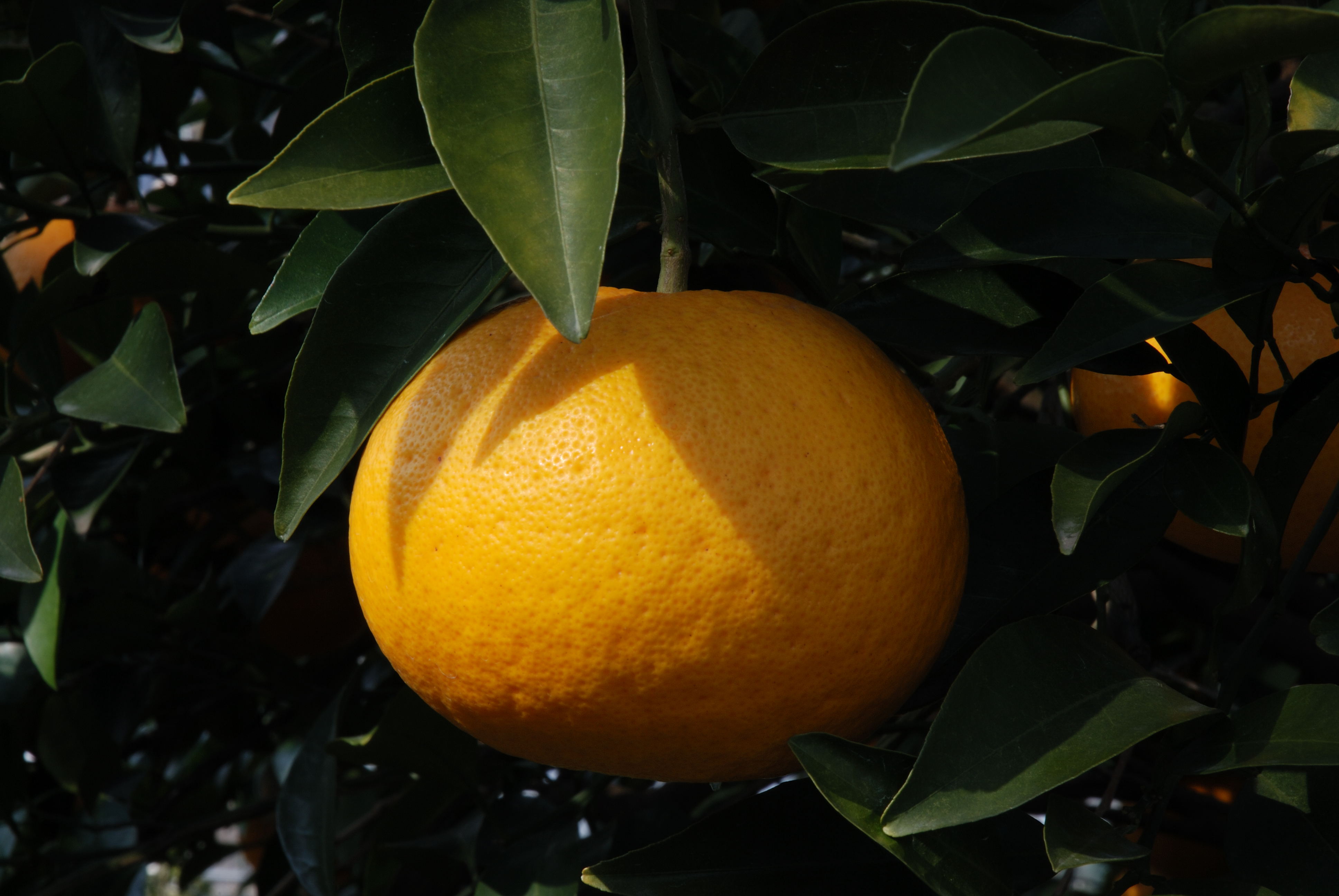|
Haruka (citrus)
Haruka (''Citrus tamurana'' x ''natsudaidai'') is a ''Citrus'' cultivar grown in Japan and the Korean Peninsula. Genetics and origin Haruka was first discovered in Ehime Prefecture, Japan. Once thought to be a natural mutation of the hyuganatsu (''Citrus tamurana''), it is now inferred that it is a hybrid between the hyuganatsu and natsudaidai (''Citrus natsudaidai''), with the hyuganatsu being the seed parent and the natsudaidai being the pollen parent. Description The fruit is small to medium in size (around the size of an orange) and can be round, oblate, or pyriform in shape. The rind is moderately thick (around the thickness of an orange) and is yellow in color; it is smooth but porous and is fragrant. The flesh is bright yellow in color and is separated into 10-11 segments by thin membranes. It is moderately seedy. There is a circular protrusion on the non-stem end and there is sometimes a nipple at the stem end. The flavor is very sweet but rather mild. Like the hy ... [...More Info...] [...Related Items...] OR: [Wikipedia] [Google] [Baidu] |
Citrus
''Citrus'' is a genus of flowering trees and shrubs in the rue family, Rutaceae. Plants in the genus produce citrus fruits, including important crops such as oranges, lemons, grapefruits, pomelos, and limes. The genus ''Citrus'' is native to South Asia, East Asia, Southeast Asia, Melanesia, and Australia. Various citrus species have been used and domesticated by indigenous cultures in these areas since ancient times. From there its cultivation spread into Micronesia and Polynesia by the Austronesian expansion (c. 3000–1500 BCE); and to the Middle East and the Mediterranean (c. 1200 BCE) via the incense trade route, and onwards to Europe and the Americas. History Citrus plants are native to subtropical and tropical regions of Asia, Island Southeast Asia, Near Oceania, and northeastern Australia. Domestication of citrus species involved much hybridization and introgression, leaving much uncertainty about when and where domestication first happened. A genomic, phylo ... [...More Info...] [...Related Items...] OR: [Wikipedia] [Google] [Baidu] |
Japanese Fruit
The following is a list of ingredients used in Japanese cuisine. Plant sources Cereal grain * Rice **Short or medium grain white rice. Regular (non-sticky) rice is called ''uruchi-mai''. **Mochi rice ( glutinous rice)-sticky rice, sweet rice ** genmai (brown rice) **rice bran (''nuka'') - not usually eaten itself, but used for pickling, and also added to boiling water to parboil tart vegetables ** arare - toasted brown rice grains in genmai cha and chazuke nori **''kome-kōji'' - ''Aspergillus'' cultures **''sake kasu'' **'' sake'' * awa (''mochi awa'') * ''oshimugi'' ( barley) Flour *katakuri starch - an alternative ingredient for potato starch *kinako - soybean flour/meal * kibi (millet) flour * konnyaku starch powder *kudzu starch *Rice flour (''komeko'') **' **' **' **', semi-cooked rice dried and coarsely pulverized; used as alternate breading in ''domyoji age'' deep-fried dish, also used in Kansai-style sakuramochi confection. Medium fine ground types are called and ... [...More Info...] [...Related Items...] OR: [Wikipedia] [Google] [Baidu] |
Edible Fruits
An edible item is any item that is safe for humans to eat. "Edible" is differentiated from "eatable" because it does not indicate how an item tastes, only whether it is fit to be eaten. Nonpoisonous items found in nature – such as some mushrooms, insects, seaweed, and so forth – are referred to as edible. Processed items that normally are not ingested but are specially manufactured to be so, like edible underwear or edible packaging, are also labeled as edible. Edible items in nature It is estimated that approximately half of about 400,000 plant species on earth are edible, yet ''Homo sapiens'' consume only about 200 plant species, because these are the simplest to domesticate. Edible plants found in nature include certain types of mushrooms, flowers, seeds, berries, seaweed, and cacti. Being able to identify the versions of these plants that are safe to eat is an important survival skill. Many animals are also edible, including domesticated livestock as well as wild ins ... [...More Info...] [...Related Items...] OR: [Wikipedia] [Google] [Baidu] |
Citrus Hybrids
Citrus taxonomy refers to the botanical classification of the species, varieties, cultivars, and graft hybrids within the genus ''Citrus'' and related genera, found in cultivation and in the wild. Citrus taxonomy is complex and controversial. Cultivated citrus are derived from various citrus species found in the wild. Some are only selections of the original wild types, many others are hybrids between two or more original species, and some are backcrossed hybrids between a hybrid and one of the hybrid's parent species. Citrus plants hybridize easily between species with completely different morphologies, and similar-looking citrus fruits may have quite different ancestries. Some differ only in disease resistance. Conversely, different-looking varieties may be nearly genetically identical, and differ only by a bud mutation. Detailed genomic analysis of wild and domesticated citrus cultivars has suggested that the progenitor of modern citrus species expanded out of the Himalaya ... [...More Info...] [...Related Items...] OR: [Wikipedia] [Google] [Baidu] |
List Of Citrus Fruits
This is a list of citrus fruits: Hybrid Citron Papeda See also * List of lemon dishes and drinks This is a list of lemon dishes and drinks, in which lemon is used as a primary ingredient. Lemon is a small evergreen tree native to Asia, and the tree's ellipsoidal yellow fruit. The fruit is used for culinary and non-culinary purposes throughou ... External links"The Citrus Family Tree" ''National Geographic'' {{DEFAULTSORT:Citrus Fruits, List Of * Lists of foods Lists of plants ... [...More Info...] [...Related Items...] OR: [Wikipedia] [Google] [Baidu] |
Japanese Citrus
A number of citrus fruits are grown in or strongly associated with Japan. Many of these fruits are of Chinese origin, but have been modified or specially bred for cultivation in Japan. Japanese taxonomy Japan usually follows the botanical names of the taxonomy from Tyôzaburô Tanaka, often referred to as the "Tanaka system", giving for each cultivar a separate name no matter if it is pure or a hybrid of two or more species or varieties. While elsewhere it is more popular to classify the genus citrus into species, and further into varieties, and then into cultivars or hybrid. Such a system was created by Walter Tennyson Swingle from Florida and is called the "Swingle system". The different approaches of the two systems lead to partially-overlapping or nested 'species', for example, ''Citrus unshiu'' and ''Citrus tangerina'' (Tanaka) versus ''Citrus reticulata'' (Swingle). Likewise, common terms, like "mikan", do not always align with these taxonomic groups. Japanese citrus ... [...More Info...] [...Related Items...] OR: [Wikipedia] [Google] [Baidu] |
Hong Kong
Hong Kong ( (US) or (UK); , ), officially the Hong Kong Special Administrative Region of the People's Republic of China (abbr. Hong Kong SAR or HKSAR), is a List of cities in China, city and Special administrative regions of China, special administrative region of China on the eastern Pearl River Delta in South China. With 7.5 million residents of various nationalities in a territory, Hong Kong is one of the List of countries and dependencies by population density, most densely populated places in the world. Hong Kong is also a major global financial centre and one of the Global city, most developed cities in the world. Hong Kong was established as a British Hong Kong, colony of the British Empire after the Qing dynasty, Qing Empire ceded Hong Kong Island from Bao'an County, Xin'an County at the end of the First Opium War in 1841 then again in 1842.. The colony expanded to the Kowloon Peninsula in 1860 after the Second Opium War and was further extended when Britain obtaine ... [...More Info...] [...Related Items...] OR: [Wikipedia] [Google] [Baidu] |
Taiwan
Taiwan, officially the Republic of China (ROC), is a country in East Asia, at the junction of the East and South China Seas in the northwestern Pacific Ocean, with the People's Republic of China (PRC) to the northwest, Japan to the northeast, and the Philippines to the south. The territories controlled by the ROC consist of 168 islands, with a combined area of . The main island of Taiwan, also known as ''Formosa'', has an area of , with mountain ranges dominating the eastern two-thirds and plains in the western third, where its highly urbanised population is concentrated. The capital, Taipei, forms along with New Taipei City and Keelung the largest metropolitan area of Taiwan. Other major cities include Taoyuan, Taichung, Tainan, and Kaohsiung. With around 23.9 million inhabitants, Taiwan is among the most densely populated countries in the world. Taiwan has been settled for at least 25,000 years. Ancestors of Taiwanese indigenous peoples settled the is ... [...More Info...] [...Related Items...] OR: [Wikipedia] [Google] [Baidu] |
Singapore
Singapore (), officially the Republic of Singapore, is a sovereign island country and city-state in maritime Southeast Asia. It lies about one degree of latitude () north of the equator, off the southern tip of the Malay Peninsula, bordering the Strait of Malacca to the west, the Singapore Strait to the south, the South China Sea to the east, and the Straits of Johor to the north. The country's territory is composed of one Singapore Island, main island, List of islands of Singapore, 63 satellite islands and islets, and Pedra Branca, Singapore, one outlying islet; the combined area of these has increased by 25% since the country's independence as a result of extensive land reclamation projects. It has the List of countries and dependencies by population density, third highest population density in the world. With a multicultural population and recognising the need to respect cultural identities of the major ethnic groups within the nation, Singapore has four Languages ... [...More Info...] [...Related Items...] OR: [Wikipedia] [Google] [Baidu] |
Hiroshima Prefecture
is a prefecture of Japan located in the Chūgoku region of Honshu. Hiroshima Prefecture has a population of 2,811,410 (1 June 2019) and has a geographic area of 8,479 km² (3,274 sq mi). Hiroshima Prefecture borders Okayama Prefecture to the east, Tottori Prefecture to the northeast, Shimane Prefecture to the north, and Yamaguchi Prefecture to the southwest. Hiroshima is the capital and largest city of Hiroshima Prefecture, and the largest city in the Chūgoku region, with other major cities including Fukuyama, Kure, and Higashihiroshima. Hiroshima Prefecture is located on the Seto Inland Sea across from the island of Shikoku, and is bounded to the north by the Chūgoku Mountains. Hiroshima Prefecture is one of the three prefectures of Japan with more than one UNESCO World Heritage Site. History The area around Hiroshima was formerly divided into Bingo Province and Aki Province. This location has been a center of trade and culture since the beginning of Japan's record ... [...More Info...] [...Related Items...] OR: [Wikipedia] [Google] [Baidu] |
Vitamin B1
Thiamine, also known as thiamin and vitamin B1, is a vitamin, an essential micronutrient, that cannot be made in the body. It is found in food and commercially synthesized to be a dietary supplement or medication. Phosphorylated forms of thiamine are required for some metabolic reactions, including the breakdown of glucose and amino acids. Food sources of thiamine include whole grains, legumes, and some meats and fish. Grain processing removes much of the vitamin content, so in many countries cereals and flours are enriched with thiamine. Supplements and medications are available to treat and prevent thiamine deficiency and disorders that result from it include beriberi and Wernicke encephalopathy. They are also used to treat maple syrup urine disease and Leigh syndrome. Supplements and medications are typically taken by mouth, but may also be given by intravenous or intramuscular injection. Thiamine supplements are generally well tolerated. Allergic reactions, including ... [...More Info...] [...Related Items...] OR: [Wikipedia] [Google] [Baidu] |



